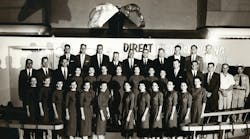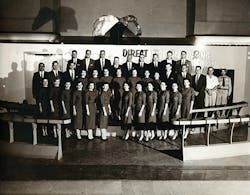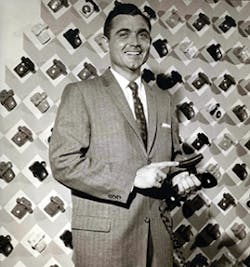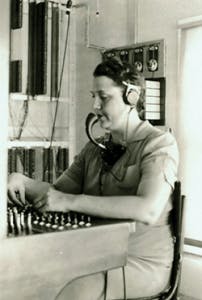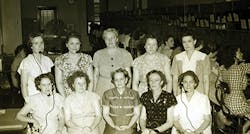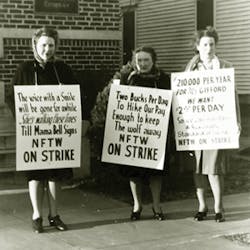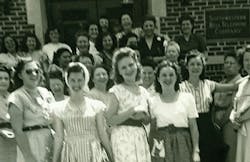9 Decades: One Family’s Memories of Ma Bell —
It is surprising how a unique sound or a scent can transport you to a place and time far from where you are today. My first memory of being in a telephone building was at Southwestern Bell Telephone Company (SWBT), 308 South Akard Street in downtown Dallas (now 3 Bell Plaza) in about 1959-60. I was 4 years old. My mother, Betty, who worked as a telephone operator prior to my birth, drove us down to meet my father, Bobby Jack Todd, at work. He was a switchman working in the central office there at that time, and he came down to the building lobby to join us. I don’t remember why. But, I do remember something that followed me through my telephone career.
There is a distinct scent to old telephone central office buildings; they were built to be indestructible, and at one time served as designated fallout shelters in case of a nuclear attack. Many things contributed to that unique scent that made an impression on this young boy: the massive cables brought into the cable vaults; the intricate coated twine Western Electric used to lash the cables throughout the offices; and the relay racks and bays of electromechanical switches.
Some 20 years later, in May 1980, I was promoted into my first management job at SWBT, and entered that same lobby to meet the personnel manager to receive my first assignment — and that same unique scent of the old switching office was still there, still familiar to me.
Figure 1. Telephone Exhibit, State Fair of Texas, Dallas, 1956. Middle row, far left: My father, Bobby Jack Todd. Southwestern Bell Telephone Company participated in a big way at the Exposition Hall of the State Fair of Texas in the 1950s. In 1956, the big promotion was "Direct Distance Dialing", or making long distance calls without the assistance of an operator. Statistics from Billboard Magazine in 1956 stated that over 500,000 people visited the SWBT exhibit that year.
Telephone Genes
My father, Bobby Jack Todd, was what we called an "old school" telephone man. He started working outside in construction as a lineman’s helper right out of high school in 1946, and spent time at virtually every technical job in the company by the time he was promoted into management in the early 1960s. (See Figures 1 and 2.)
Figure 2. Bobby Jack Todd, Switchman at the State Fair of Texas, Telephone Exhibit, 1956.
In truth, his telephone career started much earlier. In 1934, Julia Christine (Christine), my grandmother, got a job as THE telephone operator in Anna, Texas, about 20 miles north of Dallas.
The telephone office of that time was the front room of a house where they lived. My dad was 7 years old when they moved into the house that was also the telephone office. The great Depression was in full force at that time, and Grandma’s job helped pull them through. (See Figure 3.)
Figure 3. Julia Christine Todd, my grandmother, circa 1934 at the old cord board in Anna, Texas.
Those were the days when you used old cranks on the phone instead of a dial or dial pad. If you wanted to make a call, you’d spin the crank to charge a magneto, and it would turn on a light and a buzzer at the cord board at the central station. The operator would answer, and you would tell her who you wanted to call. Then, she’d patch you through by connecting the cord coming from your cable pair to the recipient. When a bell would ring on their end and they answered, the operator would drop off the line. (Or, not. You see, the telephone operators of the day knew everything happening in town.)
When Grandmother had to prepare meals for the family and was in the kitchen, Dad or Grandfather would catch the lights and buzzers, and patch the calls through.
Sometime around 1940, my family moved up to Denison, Texas, near the Oklahoma border. A lot of business came through the Katy Railroad in the day, and it was a busy town. My grandmother became the assistant chief operator. (See Figure 4.). This picture gives you some idea of how labor-intensive running the telephone business used to be.
Figure 4. Chief Operators and Service Assistants, Denison, Texas, 1947. Note all the operators in the background. Front row, l. to rt.: Ludy Cantrell, Mildred Price, Maebelle Howard, Carrie Mae Mathis, Lily Hairsine. Back row, l. to rt.: Elsie Gray, Christine Todd (my grandmother, assistant chief operator), Ada Posey, Durelle Sharp, Alice Ivie.
That little office was a 24-hours-a-day operation, with a lot of operators and technicians to support them. After Grandmother retired in about 1964, I learned that many of the friends I came to know when I was a small boy were the operators, technicians, and managers that worked with them over the years.
Figure 5. Striking employees walking the picket line. L. to rt.: Christine Todd (my grandmother, union officer, and steward), Ms. Krat, Ms. Rothner.
Somewhere along the line, Grandmother became very involved with the union. She became a union officer, and steward, and was devoted to their cause. She took trips down to Dallas, Ft. Worth, St. Louis, and all the way up to Illinois and Ohio to attend union functions in the 1940s and 1950s. I remember her talking a lot about the big strike from March 7 through May 17, 1947. WWII had just ended, and I’m sure a lot of sacrifices were made over those years. They went on strike for about 10 weeks, asking for a $2/day raise, and to get health insurance for the first time. (See Figures 5 and 6.) Grandmother and her colleagues finally got the company to concede to their cause, and my grandmother was very proud.
Also in 1947, my parents got married, and my mother, Betty, got a job as an operator in Denison while my father worked as a lineman’s helper. It was a prosperous time for America, and for the telephone companies, too. My parents combined paychecks were about $35/week — so that gives you an idea of what "prosperous" meant after the war.
Figure 6. After the strike ended. Back to work in front of the telephone building, May 17, 1947, Denison, Texas.
In 1963, Dad got his first management job as a wire chief in Mineola, Texas. He was in craft jobs for almost 20 years before his first management job, and he had worked as a lineman’s helper, lineman, cable splicer, switchman, a test desk technician, and probably more that I don’t recall. He had literally grown up in a telephone office, so he really knew just about every job in the telephone company by the early 1960s.
I was in 1st or 2nd grade when Dad got his first management job, and we moved to a new town just about every year after that until I was in high school. The first and second level management jobs of the day were chiefs: wire chief, equipment chief, assignment chief, etc. Eventually we got to Ft. Worth, Texas, in 1971, where he was District Manager — Ft Worth & Suburban-Construction. (See Figure 7.) He stayed there until his retirement in 1981. In this job, he was responsible for construction in the Ft. Worth metro and rural areas of north Texas from Wichita Falls east to Texarkana. Dallas metro was its own district, and at the time his peer in Dallas was a man named Ed Whitacre.
Figure 7. That’s my dad, Bobby Jack Todd, District Manager – Ft. Worth & Suburban-Construction, at the office, 1971, Ft. Worth, Texas.
I remember coming home from school one day in 1973 or so, and Dad called me to help with an unlikely task while he was taking care of a cable cut outside of Ft. Worth. He asked me if I could give his colleague, Mr. Whitacre, a ride back to his car at the SWBT work center in Bedford. Of course, I did it without hesitation. I’ll never forget that experience because that evening Dad told me "that man will be the president of SWBT someday." Some 20 years later, he was.
The Next Generation
I stayed with SWBT through divestiture until 1988, and then left to pursue opportunities in our industry designing and manufacturing products for the network. Today, as I approach my retirement years, it’s been a privilege to look back through 9 decades of pictures and share memories of my family’s contributions to a piece of our heritage.
As the years have passed, technology has changed the fabric of the network, and the ways in which we communicate. And the new technology just keeps on coming. But as I look at that picture of my grandmother sitting at the cord board in 1934, I know that one thing has never changed: it’s always been about bringing people together.
As I finish this article, I look down the hall from my office and see one of my daughters, working as a young engineer in our industry. I can’t help but wonder what she’ll remember 40 years from now.
Save
Save
Save
Save
Save
Save
Save
Save
Save




